“This post contains affiliate links. As an Amazon Associate, I earn from qualifying purchases at no additional cost to you. This helps us keep this site running and continue providing helpful content for off-grid camping enthusiasts. Thank you for your support!”
Introduction:
Water is the lifeline of survival, and in emergency situations, having a reliable water filtration system can mean the difference between life and death! Did you know that according to the World Health Organization, approximately 785 million people lack access to basic drinking water services? When disaster strikes or you’re in a remote location, knowing how to purify water becomes crucial.
Over the years, I’ve tested a wide range of water filtration systems, from ultralight straws to high-tech purifiers, and I’m here to share the best off-grid water filtration systems to keep you safe and hydrated in any survival scenario. In this comprehensive guide, we’ll dive into the pros and cons of top-tier systems, including the LifeStraw Personal Water Filter, Katadyn Pocket Water Filter, and SteriPEN Ultra UV Water Purifier, alongside other standout options. Let’s get started.
Understanding Off-Grid Water Filtration Basics
Ever found yourself in a situation where clean water seemed like liquid gold? Trust me, I’ve been there! When I first started exploring survival techniques, I quickly realized that using the best off-grid water filtration systems efficiently is way more complex than just running liquid through a cloth.
Let’s break down the survival water filtration world in a way that’ll make sense, even if you’re not a science whiz. Water purification isn’t just some fancy survival trick – it’s literally a lifesaver. In emergency scenarios, the water you drink could either keep you alive or make you seriously sick.
Types of Contaminants in Water
First things first: not all water is created equal. When we talk about the best off-grid water filtration systems, it’s the ones that deal with some nasty characters from your water. I’m talking about contaminants that sound like a horror movie cast – bacteria, viruses, parasites, heavy metals, and chemical pollutants. Each of these uninvited guests can cause everything from mild stomach issues to life-threatening diseases.
Here’s a quick breakdown of what you need to know:
Biological Contaminants
These are the microscopic troublemakers like E. coli, Giardia, and Cryptosporidium. They’re tiny but mighty when it comes to causing serious health problems.
Chemical Contaminants
Think pesticides, industrial runoff, and other synthetic chemicals that can sneak into water sources. Not something you want in your emergency drinking water!
Physical Contaminants
Sediment, dirt, and debris that make water look gross and can clog up your filtration system.
Filtration vs. Purification vs. Treatment
Now, let’s talk about filtration methods. There are three main approaches you’ll encounter:
Filtration: This is like a bouncer at a club, filtering out physical and some biological contaminants using a physical barrier.
Purification: This goes a step further, killing or removing almost all types of contaminants, including viruses that are too small for standard filters.
Treatment: Using chemical or UV methods to neutralize harmful organisms in the water.
Choosing the Right Water Filtration System
Pro tip from someone who’s learned the hard way: don’t just grab the first filter you see. Consider these crucial factors:
Filtering Capacity: How much water can it clean before needing replacement?
Portability: Can you easily carry it in a survival pack?
Durability: Will it survive rough conditions?
Effectiveness: What percentage of contaminants does it actually remove?
I remember this one camping trip where my buddy brought a cheap filter that basically did nothing. We ended up boiling water for hours, which isn’t always practical in a survival situation. Learn from my mistakes – invest in a quality system!
Common Water Filtration Technologies
Some key technologies to look out for include:
- Ceramic filters
- Activated carbon filters
- Reverse osmosis systems
- UV purification
- Chemical treatment options like iodine or chlorine tablets
The bottom line? In a survival scenario, your water filtration system is as crucial as any other piece of emergency gear. It’s not just about staying hydrated – it’s about staying healthy when traditional infrastructure fails.
Want a pro-survival hack? Always carry multiple water purification methods. A portable filter, some purification tablets, and the knowledge to boil water can be your triple threat against waterborne illnesses.
Stay prepared, stay hydrated, and most importantly, stay safe out there!
Top Off-Grid Water Filtration Systems Compared
| System | Type | What It Removes | Weight | Best For | Cost |
|---|---|---|---|---|---|
| LifeStraw Personal | Straw Filter | Bacteria, protozoa | 2 oz | Solo hikers, emergencies | $20 |
| Katadyn Pocket | Ceramic Filter | Bacteria, protozoa, microplastics | 20 oz | Long-term survival, groups | $370 |
| SteriPEN Ultra UV | UV Purifier | Bacteria, viruses, protozoa | 2.6 oz | Fast purification, travel | $100 |
| Sawyer Squeeze | Hollow Fiber | Bacteria, protozoa, microplastics | 32 oz | Solo hikers, ultralight | $32 |
| Grayl GeoPress | Press Purifier | Bacteria, viruses, chemicals | 24 oz | Global travel, viral risks | $100 |
| MSR Guardian | Pump Filter | Bacteria, viruses, protozoa | 17.3 oz | Expeditions, disaster prep | $315 |
| Berkey Gravity System | Gravity Filter | Bacteria, viruses, heavy metals | 7 lbs | Home/cabin off-grid setups | $367 |
| Sources: REI Expert Advice, CDC Water Treatment Guidelines | |||||
Deep Dive: Top Picks & Real-World Testing
1. LifeStraw Personal Water Filter: The Emergency Essential
The LifeStraw is a survival classic. I’ve carried one in my glove box and backpack for years. It’s a straw-style filter that removes 99.9999% of bacteria and 99.9% of protozoa, making it perfect for sipping directly from streams or ponds.
- Pros: Lightweight, affordable, no setup required.
- Cons: Doesn’t filter viruses or chemicals; limited to personal use.
2. Katadyn Pocket Water Filter: The Durable Workhorse
This Swiss-made ceramic filter is built like a tank. I’ve used it in the Rockies and the Amazon, and it’s never let me down. It removes bacteria, protozoa, and even microplastics, with a cartridge lifespan of 13,000 gallons.
- Pros: Extremely durable, long-lasting.
- Cons: Heavy and expensive; slower flow rate.
3. SteriPEN Ultra UV Water Purifier: The Tech-Savvy Solution
The SteriPEN uses UV light to kill bacteria, viruses, and protozoa in just 90 seconds. I tested it in a murky lake, and it worked like magic—no weird taste, just clean water.
- Pros: Fast, lightweight, effective against viruses.
- Cons: Requires batteries (or solar charging); doesn’t remove sediment.
4. Sawyer Squeeze: The Ultralight Champion
My go-to for backpacking, the Sawyer Squeeze filters 100,000 gallons and weighs just 3 ounces. Pair it with a CNOC Vecto bag for gravity-fed convenience.
- Pros: Affordable, versatile, and long-lasting.
- Cons: Clogs in silty water; requires occasional backflushing.
5. Grayl GeoPress: The All-in-One Powerhouse
This press-style purifier removes bacteria, viruses, and chemicals in one go. I used it in Southeast Asia, and it delivered crisp, clean water every time.
- Pros: Purifies and filters, sleek design.
- Cons: Cartridge lasts only 65 gallons; heavier than straw filters.
6. MSR Guardian: The Gold Standard for Viruses
Used by militaries and disaster responders, this pump filter eliminates viruses without chemicals. It’s pricey but worth it for high-risk areas.
- Pros: Self-cleaning, works in turbid water.
- Cons: Heavy and expensive.
7. Berkey Gravity System: The Off-Grid Home Essential
While not portable, the Berkey is a survivalist’s dream for cabins or bug-out locations. Its Black Berkey filters remove heavy metals like lead and arsenic, which EPA studies show are common in well water.
- Pros: Massive capacity (6,000+ gallons per filter), no plumbing needed.
- Cons: Bulky and requires setup time.
Advanced Off-Grid Water Purification Methods
Water purification is an art and a science, especially when you’re cut off from modern infrastructure. I’ve spent years studying and experimenting with advanced water purification techniques that go beyond simple filtration, and let me tell you, the world of water treatment is fascinating!
When basic filters aren’t enough, you need to level up your water purification game. Advanced methods can tackle challenges that standard filters can’t handle, dealing with everything from microscopic viruses to chemical contaminants that slip through traditional systems.
Let’s break down the most effective advanced off-grid water purification methods:
Gravity-Fed Filtration Systems
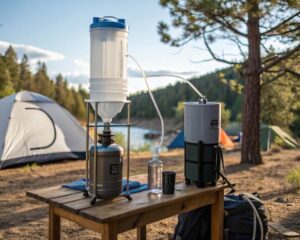 These are absolute game-changers for long-term survival situations. Unlike portable filters, gravity-fed systems can process large quantities of water with minimal effort. The system works simply: contaminated water goes in the top container, gravity pulls it through multiple filtration stages, and clean water collects at the bottom.
These are absolute game-changers for long-term survival situations. Unlike portable filters, gravity-fed systems can process large quantities of water with minimal effort. The system works simply: contaminated water goes in the top container, gravity pulls it through multiple filtration stages, and clean water collects at the bottom.
Key Components of an Advanced Gravity-Fed System:
- Ceramic filter elements
- Activated carbon filters
- Ion exchange layers
- Sediment pre-filters
Pro tip: The best gravity-fed systems can remove up to 99.9999% of bacteria, protozoa, and significantly reduce heavy metals and chemical contaminants.
UV Water Purification Technology
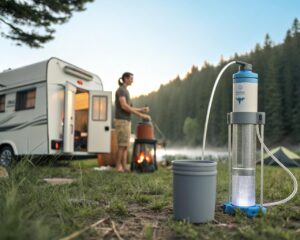 Ultraviolet light is like kryptonite for microorganisms. UV purification systems use specific wavelengths of light to destroy the DNA of bacteria, viruses, and parasites, rendering them unable to reproduce or cause infection. It’s like a microscopic death ray for waterborne pathogens!
Ultraviolet light is like kryptonite for microorganisms. UV purification systems use specific wavelengths of light to destroy the DNA of bacteria, viruses, and parasites, rendering them unable to reproduce or cause infection. It’s like a microscopic death ray for waterborne pathogens!
Important Considerations for UV Purification:
- Requires clear water (pre-filtration is crucial)
- Needs battery or solar power
- Works quickly – typically purifies water in 60 seconds or less
- Doesn’t remove chemical contaminants
Chemical Treatment Options
When you’re in a pinch, chemical treatments can be a lifesaver. These include:
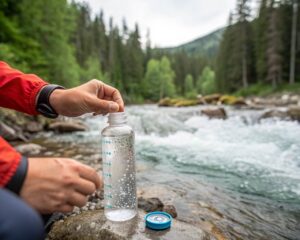 Iodine Tablets
Iodine Tablets
- Lightweight and easy to carry
- Effective against most bacteria and viruses
- Leaves a slight taste in water
- Not recommended for pregnant women or those with thyroid issues
Chlorine Dioxide Treatments
- A broader spectrum of pathogen elimination
- Kills viruses, bacteria, and some parasites
- Less taste impact compared to iodine
- Longer treatment time (4 hours for full effectiveness)
Solar Water Purification Methods
Harness the power of the sun to create clean drinking water! Solar purification works through two primary methods:
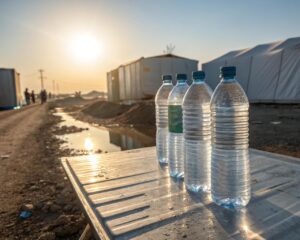 SODIS (Solar Water Disinfection) Method:
SODIS (Solar Water Disinfection) Method:
- Fill clear plastic bottles with water
- Expose to direct sunlight for 6+ hours
- UV rays and heat kill harmful microorganisms
- Works best in hot, sunny climates
Solar Stills:
- Create a device that uses solar heat to evaporate and recondense water
- Removes nearly all contaminants
- Requires a more complex setup
- Highly effective in extracting clean water from almost any source
Critical Survival Considerations
- No single method is 100% foolproof
- Always combine multiple purification techniques
- Understand the specific contaminants in your water source
- Practice these methods before an emergency occurs
In a true survival scenario, combine methods. For example, use a gravity filter to remove sediment, then follow up with UV purification and chemical treatment for maximum protection.
The world of water purification is constantly evolving. Technology is giving us more powerful tools to create safe drinking water in even the most challenging environments. But remember, knowledge is your most important tool. Understanding these advanced methods could literally save your life.
Stay curious, stay prepared, and never take clean water for granted!
DIY Water Filtration Techniques for Survival
When civilization breaks down and you’re left with nothing but your wits and the resources around you, knowing how to create a water filtration system from scratch could be the difference between survival and disaster. I’ve spent countless hours experimenting with improvised water filtration methods, and I’m about to share some life-saving techniques that could keep you hydrated in the most challenging conditions.
Let’s get real – commercial water filters are great, but what happens when you’ve lost your gear or run out of replacement cartridges? Nature provides us with incredible resources that can be transformed into effective water purification systems with a little creativity and knowledge.
Layered Natural Filtration Technique
The most fundamental DIY water filtration method involves creating a multi-layer filter using materials you can find in nature.
Step-by-Step Breakdown:
Large Container Layer:
- Use a large plastic bottle, bucket, or even a hollowed-out log
- Cut the bottom off to create a funnel-like container
- Punch small drainage holes in the bottom
Filtration Layers (from bottom to top):
- Charcoal layer – Crushed charcoal from your campfire (most crucial component)
- Activated charcoal removes chemicals, toxins, and improves taste
- Sand layer – Fine grain sand for removing sediment
- Gravel layer – Larger stones to catch bigger particles
- Cloth or grass layer – Final filter to catch remaining debris

Pro Survival Tip: Always collect charcoal from a clean wood fire. Avoid using charcoal from treated wood or unknown sources.
Emergency Transpiration Bag Technique
This method uses plant transpiration to collect pure water:
How It Works:
- Find a leafy tree branch with green leaves
- Cover the branch with a clear plastic bag
- Tie the bag securely around the branch
- Water will condense inside the bag
- Collect the pure, filtered water that transpires from the leaves
Ceramic and Cloth Improvised Filter
Materials Needed:
- Ceramic material (clay pot, broken ceramic pieces)
- Clean cloth (cotton works best)
- Container for collecting water
Technique:
- Create a ceramic filter by making small holes in a ceramic container
- Line the container with multiple layers of clean cloth
- Pour water through the ceramic filter
- Cloth acts as an additional filtration layer
Solar Disinfection Method
When chemical treatments aren’t available, the sun becomes your purification tool:
Steps for Solar Purification:
- Use clear plastic bottles
- Fill bottles with water
- Expose to direct sunlight for 6-8 hours (longer in cloudy conditions)
- UV rays and heat kill most harmful microorganisms
Critical Survival Considerations
- No DIY method is 100% foolproof
- Always combine multiple purification techniques
- If possible, boil water after filtration
- Look for the clearest water source available
Psychological Survival Note
In emergency situations, the act of purifying water isn’t just about hydration – it’s about maintaining hope and taking control of your survival.
Common Mistakes to Avoid
- Don’t assume all-natural filtration methods remove all contaminants
- Always have a backup purification method
- Learn to identify clean water sources
- Practice these techniques before an emergency occurs
Advanced Survival Hack
Create a portable filtration kit using:
- Coffee filters
- Fine sand
- Activated charcoal
- Small container
- Clean cloth
Remember, water filtration is part science, part art. The human body can survive weeks without food, but only days without water. These DIY techniques aren’t just cool survival tricks – they’re potentially life-saving skills.
Stay resourceful, stay prepared, and never stop learning!
Maintenance and Long-Term Storage of Water Filtration Systems
Best off-grid water filtration systems are like the unsung heroes of survival gear—they sit quietly in your emergency kit, waiting for the moment they’ll be called into action. But here’s the harsh truth: a neglected filter is about as useful as a screen door on a submarine. I’ve seen too many survival preppers make critical mistakes that render their expensive filtration systems completely useless when they need them most.
Proper maintenance isn’t just a recommendation—it’s a survival imperative. Your water filtration system is a complex piece of equipment that requires consistent care and attention. Think of it like a relationship: ignore it, and it’ll let you down when you need it most.
Cleaning Your Water Filtration System
First things first—cleaning isn’t a one-time event. It’s an ongoing process that can significantly extend the life of your filtration system. Here’s a comprehensive approach:
Regular Backwashing
- Most filters can be back washed to remove accumulated debris
- Use clean water to flush the filter in the opposite direction
- Do this after each use in challenging water conditions
- Prevents clogging and maintains optimal flow rate
Chemical Sanitization
- Use specialized cleaning solutions designed for water filters
- Avoid household cleaners that can damage filter materials
- Create a monthly sanitization schedule
- Pay extra attention to rubber seals and connection points
Drying and Storage
- Always completely dry your filter before long-term storage
- Moisture is the enemy—it can lead to mold and bacterial growth
- Use silica gel packets to absorb residual moisture
- Store in a cool, dry place away from direct sunlight
Long-Term Storage Strategies
Survival is all about preparation, and that means knowing how to store your water filtration systems for extended periods.
Storage Conditions Checklist:
- Temperature-controlled environment (50-70°F)
- Low humidity area
- Away from direct sunlight
- Protected from physical damage
- Sealed in protective cases
Pro Survival Tip: Rotate your stored filters annually. Even unused filters can degrade over time.
Replacement and Component Management
Nothing lasts forever, and water filters are no exception.
Track Filter Lifespan
- Most filters have a specific gallon capacity
- Keep a log of water processed
- Set reminders for replacement
- Don’t wait until the filter fails completely
Critical Components to Monitor
- Filter membranes
- O-rings and seals
- Activated carbon elements
- Ceramic filter components
Troubleshooting Common Filter Issues
Red Flags to Watch For:
⚠ Reduced water flow
⚠ Strange taste or odor
⚠ Visible sediment in filtered water
⚠ Physical damage to filter components
Emergency Backup Plan:
✔ Always keep spare filter elements
✔ Know how to field-repair your specific system
✔ Understand basic filtration principles as a backup
Psychological Preparedness Note
Maintaining your water filtration system isn’t just a technical task—it’s a mindset. It represents your commitment to survival and self-reliance.
Cost vs. Survival Calculation
- Annual maintenance cost: $20-$50
- Potential medical costs from waterborne illness: $1000s
The math speaks for itself.
Real-World Survival Wisdom
A well-maintained water filter is worth its weight in gold during an emergency. It’s not just a piece of equipment—it’s your lifeline.
Common Mistakes That Destroy Water Filters:
- Storing in extreme temperatures
- Inconsistent cleaning
- Ignoring manufacturer guidelines
- Forcing damaged components
Final survival hack, take photos of your filter’s condition during each maintenance cycle. This creates a visual log and helps you track potential issues early.
Stay prepared, stay hydrated, and never compromise on your water filtration system’s integrity!
Conclusion:
When it comes to survival, having reliable and the best off-grid water filtration systems isn’t just a luxury—it’s a necessity. By understanding the various options available and investing in the right technology, you can ensure access to clean, safe drinking water in even the most challenging environments. Remember, preparation is key to survival!
For more tips on this topic and general wilderness/off-grid survival, check out “Ultimate Guide to Wilderness Survival Skills“
Pro Tip: Always carry a backup (like iodine tablets or a UV pen). Water is survival currency—don’t gamble with it.
What’s your survival water horror story? Share below—let’s learn from each other’s mistakes! and don’t forget to utilize the FAQ below for clarity.
Frequently Asked Questions
1. What makes a water filtration system suitable for off-grid and emergency situations?
An ideal off-grid water filtration system should be portable, lightweight, capable of removing a wide range of contaminants (including bacteria, protozoa, and potentially viruses), have a long filter life, and operate without electricity. Key features include durability, ease of use, and the ability to filter water from various sources like streams, lakes, and potentially contaminated water supplies.
2. How long can a typical portable water filter last in emergency situations?
The lifespan of a water filter varies depending on the model and usage. Most portable filters can process between 1,000 to 4,000 liters before requiring replacement. Some advanced systems offer replaceable cartridges, while others may have backflush mechanisms to extend filter life. Always check the manufacturer’s specifications and carry spare filters or replacement components during extended trips or emergency preparedness planning.
3. What contaminants can off-grid water filtration systems typically remove?
Most high-quality off-grid water filters are designed to remove:
– Bacteria (like E. coli and Salmonella)
– Protozoa (such as Giardia and Cryptosporidium)
– Sediment and particulate matter
Many advanced systems can also filter out viruses, heavy metals, and chemical contaminants, though this capability varies by specific model. Some systems use multiple filtration stages, including activated carbon and UV purification, to provide comprehensive water treatment.
4. Are there any water filtration methods that don’t require replacement filters?
Yes, several alternative methods exist for long-term water purification without disposable filters:
– Gravity-based ceramic filters
– UV purification devices with rechargeable batteries
– Chemical purification tablets (though these have limitations)
– Distillation methods
– Solar water disinfection techniques
These methods can be valuable backup options when traditional filters are unavailable or have reached their maximum capacity.
5. How do I choose the right water filtration system for my specific needs?
Consider these key factors when selecting an off-grid water filtration system:
– Intended environment (wilderness, urban emergency, long-term survival)
– Number of people using the system
– Weight and portability requirements
– Specific water sources available in your region
– Budget constraints
– Additional features like flow rate, filter lifespan, and ease of maintenance
It’s recommended to have multiple filtration methods and always carry backup purification options to ensure water safety in unpredictable situations.
“This post contains affiliate links. As an Amazon Associate, I earn from qualifying purchases at no additional cost to you. This helps us keep this site running and continue providing helpful content for off-grid camping enthusiasts. Thank you for your support!”


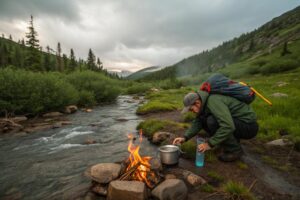

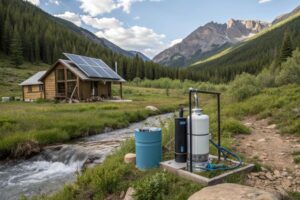
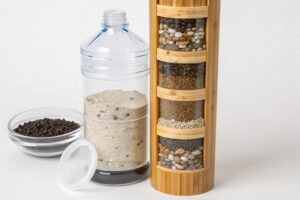

Thank you for every other great post. The place else may anybody
get that kind of information in such an ideal way of writing?
I have a presentation subsequent week, and I’m at the search for
such information.
Thank you so much for your kind words! I’m thrilled the post was helpful for your presentation. Best of luck with it next week—let me know if you need any additional tips or resources!
Your passion is infectious. It’s hard not to be excited about the subjects you explore.
Thank you!